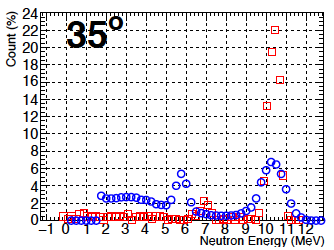Hello Everyone,
I have been working on simulating the energy spectra of p,n reaction on 7Li target (thin) at lower energies up to region of 20 MeV. The physics models which I have implemented in my code for this purpose are shown below:
Hadronic Processes for proton
Process: hadElastic
Model: hElasticLHEP: 0 eV ---> 100 TeV
Cr_sctns: GheishaElastic: 0 eV ---> 100 TeV
Process: chargeExchange
Model: Charge Exchange: 0 eV ---> 100 TeV
Cr_sctns: Glauber-Gribov nucleus nucleus: 0 eV ---> 2.88022e+295 J
Cr_sctns: GheishaElastic: 0 eV ---> 100 TeV
Process: inelastic
Model: FTFP: 4 GeV ---> 100 TeV
Model: BertiniCascade: 0 eV ---> 5 GeV
Cr_sctns: Glauber-Gribov nucleus nucleus: 0 eV ---> 2.88022e+295 J
Cr_sctns: GheishaInelastic: 0 eV ---> 100 TeV
===========================================================
As far as I understand, BertiniCascade Model produces break up continuum neutrons whereas the Charge Exchange Model (G4ChargeExchange) covers only the resonance peak of neutrons in this case.
However, the energy spectrum in the lab frame that is obtained from simulation is different from the experimental result. Comparison plot for a particular angle is attached (in Fig. blue: experimental result, red: simulation result) herewith. The peak positions and peak width of resonance neutrons are not fully matched with that of the experimental results. A discrepancy has also been observed in energy spectra of continuum neutrons at less than 5 MeV region. Note that similar type of result is observed using geant4.10.02 and geant4.10.05.
It would be helpful if someone could suggest how I could improve this simulation result. Do I need to use some other physics model or cross section?
Is the G4ChargeExchange model capable of reproducing resonance peaks of 7Li(p,n)7Be reaction and/or this kind of reaction at the lower energy region (upto 20 MeV)?
I greatly appreciate any kind of suggestions/opinion/information.
Thank you.
